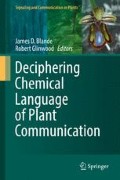Abstract
Volatile chemicals emitted by plants constitute cues and signals that provide extensive information to myriad organisms in the community. Chapters in this book provide detail on the production and emission of volatile compounds, a variety of volatile-mediated interactions involving a multitude of organisms, and recent developments on the detection of volatile compounds by plants. In this chapter a synthesis of key points and recurring themes from the previous chapters is provided, and future research directions are identified.
Access this chapter
Tax calculation will be finalised at checkout
Purchases are for personal use only
References
Arneth A, Niinemets Ü (2010) Induced BVOCs: how to bug our models? Trends Plant Sci 15:118–125
Copolovici L, Kännaste A, Remmel T, Niinemets Ü (2014) Volatile organic compound emissions from Alnus glutinosa under interacting drought and herbivory stresses. Environ Exp Bot 100:55–63
Erb M, Veyrat N, Robert CAM, Xu H, Frey M, Ton J, Turlings TCJ (2015) Indole is an essential herbivore-induced volatile priming signal in maize. Nat Commun 6:6273
Fenske MP, Hewett Hazelton KD, Hempton AK, Shim JS, Yamamoto BM, Riffell JA, Imaizumi T (2015) Circadian clock gene LATE ELONGATED HYPOCOTYL directly regulates the timing of floral scent emission in Petunia. Proc Natl Acad Sci USA 31:9775–9780
Helms AM, De Moraes CM, Tooker JF, Mescher MC (2013) Exposure of Solidago altissima plants to volatile emissions of an insect antagonist (Eurosta solidaginis) deters subsequent herbivory. Proc Natl Acad Sci USA 110:199–204
Helms AM, De Moraes CM, Mescher MC, Tooker JF (2014) The volatile emission of Eurosta solidaginis primes herbivore-induced volatile production in Solidago altissima and does not directly deter insect feeding. BMC Plant Biol 14:173
Junker RR, Tholl D (2013) Volatile organic compound mediated interactions at the plant–microbe interface. J Chem Ecol 39:810–825
Karban R, Yang LH, Edwards KF (2014a) Volatile communication between plants that affects herbivory: a meta-analysis. Ecol Lett 17:44–52
Karban R, Wetzel WC, Shiojiri K, Ishizaki S, Ramirez SR, Blande JD (2014b) Deciphering the language of plant communication: volatile chemotypes of sagebrush. New Phytol 204:380–385
Lee K, Seo PJ (2014) Airborne signals from salt-stressed Arabidopsis plants trigger salinity tolerance in neighbouring plants. Plant Signal Behav 9:e28392
Mäntylä E, Alessio GA, Blande JD, Heijari J, Holopainen JK, Laaksonen T, Piirtola P, Klemola T (2008) From plants to birds: higher avian predation rates in trees responding to insect herbivory. PLoS One 3(7):e2832
Peñuelas J, Farré-Armengol G, Llusià J, Gargallo-Garriga A, Rico L, Sardans J, Terradas J, Filella I (2014) Removal of floral microbiota reduces floral terpene emissions. Sci Rep 4:4. doi:10.1038/srep06727
Pierre PS, Jansen JJ, Hordijk CA, van Dam NM, Cortesero AM, Dugravot S (2011) Differences in volatile profiles of turnip plants subjected to single and dual herbivory above- and belowground. J Chem Ecol 37:368–377
Stam JM, Kroes A, Li YH, Gols R, van Loon JJA, Poelman EH, Dicke M (2014) Plant interactions with multiple insect herbivores: from community to genes. Annu Rev Plant Biol 65:689–713
Stork WFJ, Weinhold A, Baldwin IT (2011) Trichomes as dangerous lollipops: do lizards also use caterpillar body and frass odor to optimize their foraging? Plant Signal Behav 6:1893–1896
Sugimoto K, Matsui K, Iijima Y, Akakabe Y, Muramoto S, Ozawa R, Uefune M, Sasaki R, Alamgir KM, Akitake S, Nobuke T, Galis I, Aoki K, Shibata D, Takabayashi J (2014) Intake and transformation to a glycoside of (Z)-3-hexenol from infested neighbors reveals a mode of plant odor reception and defense. Proc Natl Acad Sci USA 111:7144–7149
Yao YL, Danna CH, Zemp FJ, Titov V, Ciftci ON, Przybylski R, Ausubel FM, Kovalchuk I (2011) UV-C-irradiated Arabidopsis and tobacco emit volatiles that trigger genomic instability in neighbouring plants. Plant Cell 23:3824–3852
Yon F, Joo Y, Llorca LC, Rothe E, Baldwin IT, Kim S-G (2016) Silencing Nicotiana attenuata LHY and ZTL alters circadian rhythms in flowers. New Phytol 209:1058–1066
Zebelo SA, Matsui K, Ozawa R, Maffei ME (2012) Plasma membrane potential depolarization and cytosolic calcium flux are early events involved in tomato (Solanum lycopersicon) plant-to-plant communication. Plant Sci 196:93–100
Author information
Authors and Affiliations
Corresponding author
Editor information
Editors and Affiliations
Rights and permissions
Copyright information
© 2016 Springer International Publishing Switzerland
About this chapter
Cite this chapter
Glinwood, R., Blande, J.D. (2016). Deciphering Chemical Language of Plant Communication: Synthesis and Future Research Directions. In: Blande, J., Glinwood, R. (eds) Deciphering Chemical Language of Plant Communication. Signaling and Communication in Plants. Springer, Cham. https://doi.org/10.1007/978-3-319-33498-1_14
Download citation
DOI: https://doi.org/10.1007/978-3-319-33498-1_14
Published:
Publisher Name: Springer, Cham
Print ISBN: 978-3-319-33496-7
Online ISBN: 978-3-319-33498-1
eBook Packages: Biomedical and Life SciencesBiomedical and Life Sciences (R0)

